This is a Canon T80, a 35mm SLR camera produced by Canon from April 1985 to June 1986. It was Canon’s first attempt at Auto Focus in a SLR, using three special AC lenses developed for it which had a self contained Auto Focus motor in each lens. The T80 uses a Linear CCD system first developed for the earlier Canon AL-1 which detects focus by measuring peak contrast within the viewfinder. Focus information is passed to the lens servo through 6 electrical contacts within the lens mount. The lens mount was a modified Canon FD bayonet mount which was compatible with most previous FD mount lenses, although without auto focus capability. The T80 was an innovative, but short lived camera, and served only to bridge the gap between Canon’s manual focus T-series and their soon to be released EOS lineup.
Film Type: 135 (35mm)
Lens: 50mm f/1.8 Canon AC coated 6-elements
Lens Mount: Canon FD AC Bayonet
Focus: 0.6 meters to Infinity, Single Shot Automatic, Continuous Automatic, or Manual Focus via AC Lenses
Viewfinder: Fixed SLR Pentaprism with Horizontal and Vertical Split Image Focus Aide and Groundglass Circle
Shutter: Canon EMAS-II Electronic Vertically Traveling Focal Plane
Speeds (Automatic): 2 – 1/1000 seconds, stepless
Speeds (Manual): B, 1/60
Exposure Meter: TTL Coupled Silicon Photo Diode w/ Multi-Program AE
Battery: (4x) 1.5v AAA Battery
Flash Mount: Hotshoe, 1/90 X-sync
Weight: 804 grams (w/ lens and batteries), 592 grams (batteries only)
Manual: https://www.cameramanuals.org/canon_pdf/canon_t80.pdf
How these ratings work |
The Canon T80 was Canon’s first auto focus SLR and despite being a predominantly automatic only camera, is actually quite capable. It’s AC series lenses are slow to focus, but once they get it, are just as good as any other Canon lenses of the era. The best part about the T80 is it’s ability to give focus confirmation on any Canon FD, FL, or R-mount lens with an audible beep. The metering modes on the camera are very accurate and deliver some outstanding results. I won’t go as far as to say I’d prefer this camera over other, more well rounded SLRs of the era, but for a stop-gap model that was only available for a very short period of time, Canon did more right with it, than wrong. | ||||||
| Images | Handling | Features | Viewfinder | Feel & Beauty | History | Age | |
| 2 | 1 | 1 | 2 | 1 | 2 | 0% | |
| Bonus | +1 for historical significance, the first Canon Auto Focus SLR | ||||||
| Final Score | 10.0 | ||||||
History
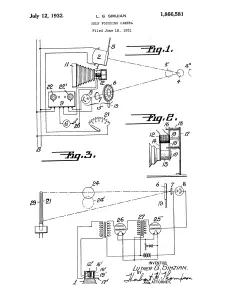
In April 1985, Canon would release the T80, their first auto focus SLR. It was a big step forward for Canon as until then, the company’s only available cameras with automatic focus were in their lineup of compact point and shoot cameras like the Canon AF35M.
Despite this accolade, the T80 was only a stop gap model as it’s auto focus feature required one of three available “AC” or “automatic control” lenses developed for it to work. When the T80 was mounted with a non-AC lens, it was manual focus only.
Several other companies had experimented with similar stop gap designs, such as the Nikon F3AF in 1983, and the Pentax ME F from 1981 which worked in the same way where they required the use of a limited number of specialized auto focus lenses for the feature to work.
In 1981, Canon released a self contained auto focus lens, the Canon FD 35-70mm f/4 AF which did not require any specific auto focus body, instead relying on a built in triangulation system borrowed from their point and shoots and adding a motor to a large box that protruded out of the side.
Prior to the 1980s, the first auto focus SLR of any film format was the Polaroid SX-70 Sonar from 1978, a folding instant camera with an externally mounted auto focus sensor that used sonar to detect distances from an object. Although an inefficient method for focus detection, it had the benefit of working in total darkness, something that even the most modern systems can struggle with. The camera looked just like a regular SX-70, but with a large black sensor mounted to the top.
At Photokina in September 1976, Leitz debuted their new “Correphot” auto focus SLR, a heavily modified Leica R4 with an in body auto focus system. Leitz’s system used twin CdS exposure meters that through some electronic voodoo, could detect the sharpest moments of contrast and compare them between both sensors to achieve a sharply focused image. The auto focus system was contained within the body but still required the user to manually focus the lens, or with an optional attachment and specialized lenses, true automatic focus could be achieved. Although it was said that Leitz’s system worked, they abandoned the technology shortly after it’s announcement, selling it to Minolta, as they didn’t think the typical Leica user would ever need it.
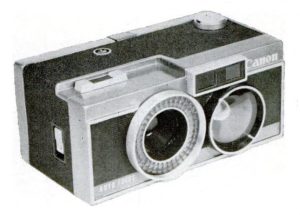
In June 1963 at Photokina, Canon revealed a new auto focusing rangefinder camera, simply called the “Canon Autofocus”.
The camera was a strange looking twin lens rangefinder that had a normal 40mm f/2.8 lens surrounded by a selenium cell exposure meter, but on the other side was a 75mm f/2 mirror lens that sent a magnified image through a beam splitter to the center of the main viewfinder window like a traditional coincident image rangefinder. The camera’s automatic motors and various electronic gizmos automatically swept through the full focus range, analyzing the light coming through the rangefinder, and when the two images lined up, a sensor would detect a brief moment of increased contrast (since the images are overlapping each other like in a normal rangefinder), and triggered an electronic circuit that fired the shutter. It is said this whole sequence took less than a second and supposedly was quite accurate. The camera was merely a prototype though and never went into production, so there has never been anyone who could confirm it’s functionality.
Going back even farther than 1963, various patents and other miscellaneous ideas were thrown around by a large number of companies like Voigtländer, Kodak, and others for how to automatically focus a lens. The oldest on record is US Patent 1,866,581, submitted on June 6, 1931 by an Armenian inventor named Luther George Simjian.
Fast forward to the 1980s and Canon was well aware of the need to include auto focus in more of their models. Their compact point and shoot AF models were doing well, but like every other Japanese camera maker, this wasn’t translating to the SLR market. Canon knew that day would come however, and made incremental steps towards releasing their first AF SLR.
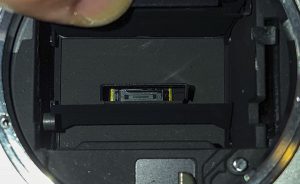
That first step would come with the short lived Canon AL-1 from 1982. Featuring a clever sub-mirror behind the primary semi-transparent mirror that reflected light into a three CCD line sensor at the bottom of the reflex mirror box to determine focus by peak contrast, the AL-1 could detect a properly focused image and alert the photographer via a focus confirmation light in the viewfinder. The AL-1 was still a manual focus camera, but allowed Canon to experiment with how an auto focus system might work in an SLR, while maintaining support for their entire lineup of manual focus lenses.
Using their knowledge from that camera, in April 1985, Canon would take their next step with the Canon T80. Using the AL-1’s three CCD line sensor, they gave the T80 full auto focus capability with a revised lens mount that featured 6 electrical contact pins that could communicate to one of three available AC (Automatic Control) lenses that had their own in-lens micromotors to automatically focus to the same distance that the CCD sensor detected.
Like the AL-1, the T80 still maintained support for Canon’s manual focus lenses, and could signal the photographer when proper focus is achieved, via an audible beep. When it was released, it had a retail price of $520 including the 50mm f/1.8 AC lens, which when adjusted for inflation is comparable to $1250 today. As was the case with most cameras, the street price for the T80 was likely quite a bit cheaper, especially into early 1986 when Canon was on the verge of releasing the much improved EOS and other manufacturers like Minolta were releasing their auto focus cameras. I would be willing to bet that brand new examples of the T80 could be purchased for half that price within 12 months of it’s release.
When it was released in 1985, the Canon T80 generated quite a bit excitement as it was the first 35mm SLR with auto focus to be released by Canon, who at the time was the world’s second largest maker of cameras. The following two articles both appeared in the May 1985 issues of Popular and Modern Photography and served as an intro to the new model, covering it’s many highlights and a few of it’s missteps.
The first article, from Thom O’Connor gives some hands-on experience in which the author gives generally good praise to the futuristic body and build quality of the polycarbonate covered metal body. In his test, he was able to use the longer zoom lenses, capturing some impressive shots of people in motion, although later reveals that the best results achieved by this camera require pre-focusing and firing the shutter when the object was in that range, mostly negating the benefits of the automatic focus.
He mentions more than once how the auto focus system would often hunt for the correct distance, especially in low light, but would eventually get it right. His biggest criticisms however, were of Canon’s “pictograph” metering system in which the top LCD display shows one of four icons to refer to the camera’s different metering modes. He says the icons by themselves might confuse the novice that this camera was intended for and that he hoped that the T80s user manual, which wasn’t available to him, might do a better job of explaining the modes and their limitations (it does).
The second article from Herbert Keppler’s “SLR Notebook” series is more technical in nature, covering the camera’s different specifications and providing line charts explaining the programmed settings of each of the camera’s various modes.

Both articles refer to the Minolta Maxxum 7000 which was already on the market at the time of the T80’s release, comparing the two ideologies between the two cameras in which metering, focus, and lens control was done entirely in the Maxxum’s body, whereas Canon took the approach of using external motors grafted onto the sides of the T80’s AC lenses. Minolta’s implementation was more advanced and elegant, but came with an entirely new lens mount that was not backwards compatible with the company’s earlier lenses, whereas Canon stuck with the FD mount meaning the T80 could also use the entire selection of the company’s manual focus lenses.
We have the benefit today of hindsight to know that the Maxxum 7000 was tremendously successful, catapulting Minolta into the lead of 35mm auto focus development and their decision to switch lens mounts was a wise one, and foreshadows Canon’s decision to do the same thing with their upcoming EOS series.
Today, cameras like the Canon T80 represent a short lived curiosity of stop gap models that were released at the dawn of the SLR auto focus era. Their performance is nowhere near to the level of future AF cameras that would be released in the years to come, but that shouldn’t surprise anyone. The Canon T80 is unique in that it offered a glimpse as to what might have happened if Canon would have never released the EOS EF mount and just adapted their older mount to accommodate AF like Nikon did. This is a surprisingly capable camera, and one that looks like no other released by Canon or anyone else, and for those reasons, I think is worthy of checking out by any collector or photographer today.
My Thoughts
My experience with early auto focus cameras was with the likes of the Canon AF35M and Pentax PC35AF. I had previously shot the Canon AL-1 which although not an auto focus camera, did have an early type of focus detection that would display a focus confirmation light within the viewfinder when the lens was manually focused correctly. So when my friend Adam Paul had told me about the Canon T80 he had picked up, I was interested. Adam gave the camera pretty high praise, saying the focus detection was fine for most general photography, and was only challenged on closeups and fast moving objects.
His praise was good enough that I sought one out for myself, and eventually I wound up with this nice example with the 50mm f/1.8 AC lens and took it out shooting.

Knowing that this camera was essentially a Canon T50 but with auto focus, I expected the build quality to be decent, but not great.
Canon released the AE-1 in 1976 and was their first attempt at building an SLR with non-metal exterior surfaces. Using a variety of synthetic materials, Canon’s A-series mimicked the look of chrome and black painted metal cameras using a material that was cheaper to produce, weighed less, and was more durable. With the T-Series, Canon made no attempt to make their bodies look like the classic metal designs of the 60s and 70s.
Instead featuring a gray painted polycarbonate body, the T-series never won any beauty pageants. Often dismissed as cheap, low end cameras, with the exception of the semi-pro Canon T90, no other model in this series is highly sought out by collectors.
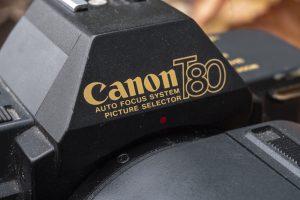
In terms of build quality, the T80 is on par with the T50 and T70, which is to say, good, but not great. The camera does not creak in your hands and has a tactile feel that is at least as good as modern cameras made today. Underneath the fiberglass reinforced polycarbonate body, lies an aluminum body and zinc lens mount and mirror box. The gray painted body isn’t exactly ugly, but when it is scratched or parts of the paint are worn off, instead of seeing a beautiful brassing like on cameras of yore, you see the raw plastic in a weird grayish color.
With the 50mm f/1.8 AC lens mounted and four AAA batteries installed, the camera weighs a not-insignificant 804 grams. Certainly not a beast, but not lightweight either. When it was new, Canon suggested a fresh set of batteries could power the camera through forty 36-exposure rolls of film. The pronounced hand grip on the camera’s right side makes extended shooting sessions comfortable although the location of the left strap eyelet at the top of the handgrip is a curious location as it interferes with the shutter release immediately behind it.

The top plate of the T80 is like a cross between the T50’s almost control-less design, and the T70 including an LCD screen that gives basic info about what’s going on with the camera. On the left side are buttons for AE Mode selection, ISO film speed, and a Battery Check button. The camera does offer a Manual mode which disables AE, but it only allows for a single 1/60 shutter speed, so it’s not exactly a true manual mode like you’d expect on more advanced cameras.
Above the prism is a flash hot shoe with contacts specifically designed for either of Canon’s 244T, 277T, and 299T flashes. These flashes allow for more intelligent flash metering and with the 277T and 299T, to be used as a fill flash. Other flashes can be used as well, but may result in incorrectly exposed flash images as there is no communication between the camera and the flash.
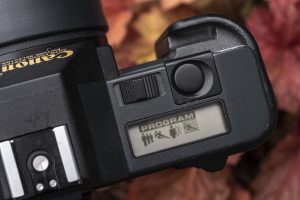
On the right side is the shutter release button, an LCD display screen and a slider switch for selecting the camera’s various modes.
The LCD screen has a permanently painted PROGRAM label, plus 4 different icons, which Canon refers to as Pictograms. With the camera in AE mode, you can use the slider to select from the following exposure modes:
- Deep – Increased depth of field for landscapes (slower shutter speeds, smaller aperture).
- Shallow – Decreased depth of field for closeups or blurred backgrounds (faster shutter speed, wider aperture).
- Stop Action – Prioritizes faster shutter speeds for fast motion.
- Flowing – Allows for manual selection of speeds 15-125 for intentionally blurred focus, like when capturing moving objects. This mode allows the camera to be used in a limited shutter priority AE mode as long as you choose one of these 5 speeds.
- Standard Program – For all other shots where you want to trust the camera to pick what it thinks is the best speed and f/stops
The LCD will also show various combinations of exposures shot, ISO film speed, self timer countdown, flash charge status (when using the 244T, 277T, or 299T), aperture stop down mode (when using Canon FL lenses, bellows, or extension tubes), film transport/rewind indicator, battery charge indicator, shutter speed in “Flowing” pictogram mode, Bulb, and an icon indicating the audible beeper is on.
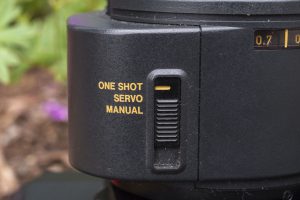
With one of the three AC lenses made for the T80, the top of each lens has it’s own slider for selecting the focus modes. There’s One Shot and Servo, which translate to Single and Continuous on modern cameras, and an option for Manual which disengages the auto focus motor and allows you to manually focus the camera in tricky focus situations. While it was smart for Canon to realize their early attempt at auto focus wouldn’t be perfect and include a manual focus option, the implementation of this is clunky, but I’ll get to that later.
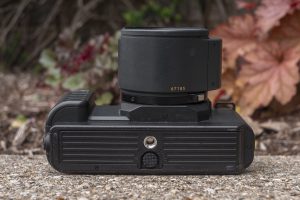
Flipping the camera over we see a centrally located 1/4″ tripod socket surrounded entirely by the door for the battery compartment. The T80 requires four AAA batteries that when this door is removed, take up almost the entirety of the bottom of the camera.
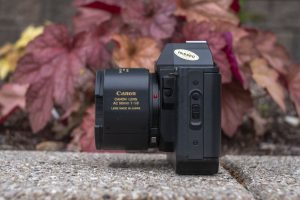
The camera’s left side is the more interesting of the two, showing a label for the AC lens on the lens itself, and on the camera, the release latch for the film compartment door.
Sandwiched between the lens and the body are an unlabeled +1.5EV exposure compensation button for back lit shots, and a chrome lens release button for swapping lenses.
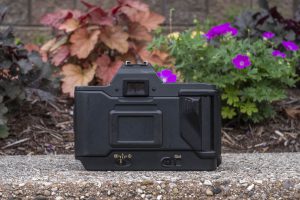
The back of the camera has a film reminder holder, and a contoured grip on the right side which increases the comfort of your right thumb when holding the camera.
Near the bottom are a slider for turning the camera off and on, and engaging the self timer, and a manual rewind button. The T80 requires power so with the camera off, all functions are locked. I find it strange that they chose to label this switch L and A, when Off and On would have been more appropriate.
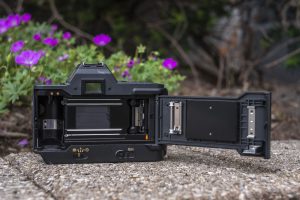
With the film compartment opened, we see a semi-modern looking film compartment. Film transport is from left to right on a fixed quick load take up spool. Simply extend the leader of a new roll of film to the orange mark and then close the door and the camera does the rest. The inside of the door has an oversized pressure plate and a combination of rollers and springs to help maintain flatness as film transports through the camera.
The reason I say “semi-modern” is that the T80 lacks the electrical contacts for DX encoding and it does not support automatic rewind at the end of a roll. In order to rewind a completed roll of film, you must press the rewind button to engage the electronic rewind motor.
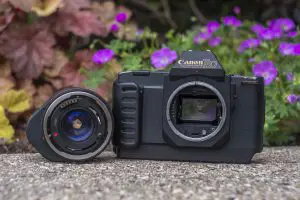
The T80 uses the Canon FD mount like all other Canon SLRs prior to the EOS series, but the three auto focus AC lenses developed for it used what was called the “New FD” mount which eliminated the often troublesome breech lock ring that was used on earlier FD lenses.
Removing a New FD lens from the T80 requires you to press and hold a chrome release button near the 4 o’clock position around the lens and twist the entire lens counterclockwise. Remounting the lens simply requires you to line up a red dot on the lens and the camera body and then twist clockwise until it locks in place. Although it doesn’t seem like it, the primary benefit of the breech lock system in which the mating surface between the lens and camera body never moves, is still retained with New FD lenses. The difference is that the entire body of the lens functions as the breech lock ring.
The Canon T80 is backwards compatible with nearly every manual focus FD, FL, and Canon R mount lens, extension tube, and bellows with a few compromises depending on what you’re using.
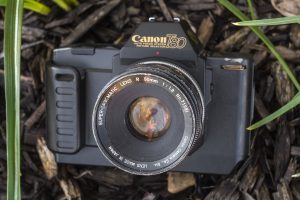
- Canon FL and R mount lenses, and all extension tubes and bellows attachments – The camera must be used in stopped down AE mode, as indicated by a small iris icon on the top plate LCD. In this mode, open aperture metering is not possible. The camera will still select an appropriate shutter speed, but the lenses stay stopped down depending on which f/stop is selected on the lens. You may also set the camera to Manual exposure mode which disables the auto exposure system, and limits you to only a shutter speed of 1/60 or Bulb mode. In Bulb mode, you can press and hold the shutter release for exposures as long as 60 seconds. With the Command Back 80, long exposures up to 23 hours, 59 minutes, and 59 seconds are possible. Only with FD, FL, and R mount lenses are
- Canon FD mount lenses set to Auto – With Automatic FD mount lenses, the T80 essentially becomes the Canon T50 and T70 in which the entire selection of multi-programmed auto exposure modes are still available. Open aperture metering works as expected, as does the focus confirmation light just like in the Canon AL-1.
- Canon FD mount lenses set to a specific f/stop – Once you take an FD lens off Auto mode, the camera automatically goes into full Manual mode, which disables the metering system and limits you to only a shutter speed of 1/60 or Bulb mode just like when using FL lenses.
Canon was wise to maintain backwards compatibility with older lenses while still offering some degree of automatic exposure capability and using the focus confirmation light to allow for photographers with existing lenses to benefit from the new technology of the camera. It was this flexibility that caused my friend Adam and I excitement when shooting the T80 as it modernized the shooting experience with older Canon lenses.
The other exciting thing about the T80 is the viewfinder, or more specifically, the focusing screen. Unlike any other camera I’ve ever seen, the Canon T80 has a split image focus aide that splits both horizontally and vertically. This means that regardless of whether the camera is being held in either a portrait or landscape orientation, you can see focus on both horizontal and vertical lines.
I’ve seen other cameras with diagonal split images which are supposed to work both vertically and horizontally, but the challenge with those is that due to the diagonal angle, there is less of a “split” in both horizontal and vertical images, rendering the whole thing less useful. With the T80’s screen, the center of the image is split into four quadrants, with a clear and obvious split image on any line. In the two images above, I show the viewfinder both in and out of focus, so you can more clearly see the split image focus aide.
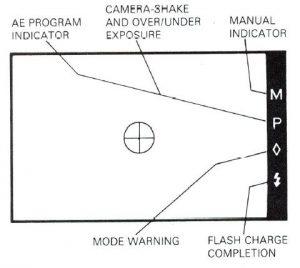 As for the rest of the viewfinder, being a mid 1980s camera, the screen is as clear and bright as you’d expect to see from any camera of the era. Composing your image in all but the worst lighting is easy, even when wearing prescription glasses. There’s nothing in the way of exposure information there, with your only clue as to what the camera is doing, appearing in the form of 4 LEDs, one indicating manual exposure mode, programmed AE with over or under warning, AE mode indicator, and a flash ready indicator.
As for the rest of the viewfinder, being a mid 1980s camera, the screen is as clear and bright as you’d expect to see from any camera of the era. Composing your image in all but the worst lighting is easy, even when wearing prescription glasses. There’s nothing in the way of exposure information there, with your only clue as to what the camera is doing, appearing in the form of 4 LEDs, one indicating manual exposure mode, programmed AE with over or under warning, AE mode indicator, and a flash ready indicator.
The Canon T80 may have been a stop gap model designed as a way to slowly introduce the world to Canon’s auto focus SLRs, but it was quite a capable camera. Canon smartly included full backwards compatibility with previous lenses, allowing for full multi-programmed AE on FD lenses, and stop down AE on FL and R-mount lenses, while still offering focus assist, an excellent viewfinder, easy film loading, and good build quality in an easy to use package for the novice photographer, or even the advanced shooter who wanted to play with auto focus.
But as I’ve discovered many times, sometimes how cool a camera appears on paper might not always translate into a capable or fun to use camera when you load film into it. Will the T80 be as good as it seems, or will it’s early implementations of auto focus and limited manual control hinder itself in the field? Keep reading…
My Results
When I set out to shoot the T80 for the first time, I was eager to see how well (or poorly) it’s auto focus system worked. I am very familiar with Canon’s ability to produce optically excellent lenses, having shot many of their SLRs before, so image quality wasn’t going to be something I would be too concerned with.
Since I was more eager to see how the camera performed rather than it’s lens, I decided to go with a film I am very familiar with, which is Fuji 200. I loaded up a fresh roll of film that had been in my freezer since Wal-Mart discontinued the 4-packs of them a couple years back, and went shooting.
In what should be a pretty unsurprising declaration, the images from the Canon T80 were excellent. Canon, like almost every other Japanese optics company had been making optically superior lenses for the better part of half a century prior to the T80’s release, so of course the images from the 50mm f/1.8 AC lens were excellent. I can’t prove this, but I am willing to bet that this is just a run of the mill 50mm f/1.8 FD SSC manual focus lens wrapped up in a new body with a focusing motor.

The programmed exposure metering system is the same as the one from previous Canon SLRs dating back to the Canon A1. When that camera was first released in 1978, it was one of the most advanced in any 35mm SLR, and is absolutely good enough here. The T80 might have had an early form of auto focus, but it’s metering system was extremely good.
This being Canon’s first auto focus SLR, you’re probably most curious about how well the auto focus system performs, and I can say it’s definitely not bad. It is no better or worse than the performance of the Minolta Maxxum 7000 or other early point and shoot auto focus cameras. It’s slow to find focus, especially in poor lighting, and it is easily tricked by fast motion objects or when shooting closeups. But I found that for general photography, it found focus within one second 80-90% of the time and in the instances where it struggled, I either just had to sit there and wait for it, or switch it over to manual focus mode to get the shot.
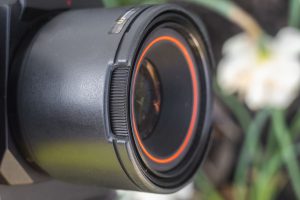
Speaking of the manual focus mode, there’s a nitpick I referenced earlier in this article that’s worth mentioning. As you might expect, the 50mm f/1.8 AC lens has a manual focusing ring at the front of the lens. Canon strangely designed it in a way where there is a shroud around most this ring except at the sides of the lens. This means that when manually focusing the lens, you can only grip it near the 3 and 9 o’clock positions around the lens. In use, it’s not a deal breaker as this is likely where most people would reach for a lens anyway, but it just seems odd to cover up probably 75% of the total circumference of the lens.
Another really small nitpick is that the T80’s excellent focus confirmation feature alerts you only with an audible beep, rather than an indicator in the viewfinder. Despite using the same system as the Canon AL-1, I much prefer the AL-1’s confirmation LED to that of a beep.
While researching this article, I read several comments from people saying the T80 was a failure or a miss step in Canon’s history, and I don’t think I agree with that.
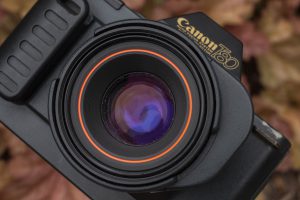
By the time the T80 was in development, Canon was well aware that there would be an increasing need for in-body auto focus SLRs and was probably already planning the release of what would become the EOS in 1986. Like most A-list Japanese camera makers, Canon typically would release new features in a short lived model both to test out the new technology, but also to seek feedback from it’s customers. The Canon EF was a short lived model and was Canon’s first SLR with an electronic shutter and auto exposure before the AE-1 was released a few years later. Nikon’s first camera with their new AI (Automatic Indexing) lenses was the very short lived Nikkormat FT3, and the Nikon FA was their first SLR with programmed AE and a top 1/4000 shutter speed. Minolta tested the waters with focus confirmation in the very hard to find X-600.
Earlier I mentioned that my friend Adam had a lot of nice things to say about the T80 before I had one of my own, and after shooting a few rolls of film in it, I agree with his comments. Yeah, it’s an early AF SLR, and it wouldn’t be fair to compare it to something like a Canon EOS-1v or Nikon F6, but for what it is, it works quite well and even offers the ability to shoot classic Canon lenses with the benefit of some type of auto exposure and focus confirmation.
Of all the Canon T-series models, the T90 was the most advanced but also is very hard to find in working condition today as it’s electronics have not aged well. Both the T50 and T70 are capable, but unremarkable cameras, and the Canon T60 wasn’t even made by Canon, leaving the T80 as my favorite of the line. It’s combination of good ergonomics, a great viewfinder, an auto focus system that works fine for a majority of regular photography, and access to Canon’s entire suite of pre-EOS lenses makes it an excellent choice today!
Related Posts You Might Enjoy
External Links
https://en.wikipedia.org/wiki/Canon_T80
http://camera-wiki.org/wiki/Canon_T80
https://global.canon/en/c-museum/product/film115.html
http://www.mir.com.my/rb/photography/companies/canon/fdresources/SLRs/canont80/index.htm
https://casualphotophile.com/2019/01/21/canon-t80-review/
https://www.photo.net/discuss/threads/canon-t80-early-autofocus-slr.471987/
http://www.mike-caine.com/canon-t80/
http://www.jollinger.com/photo/cam-coll/cameras/Canon_T80.html

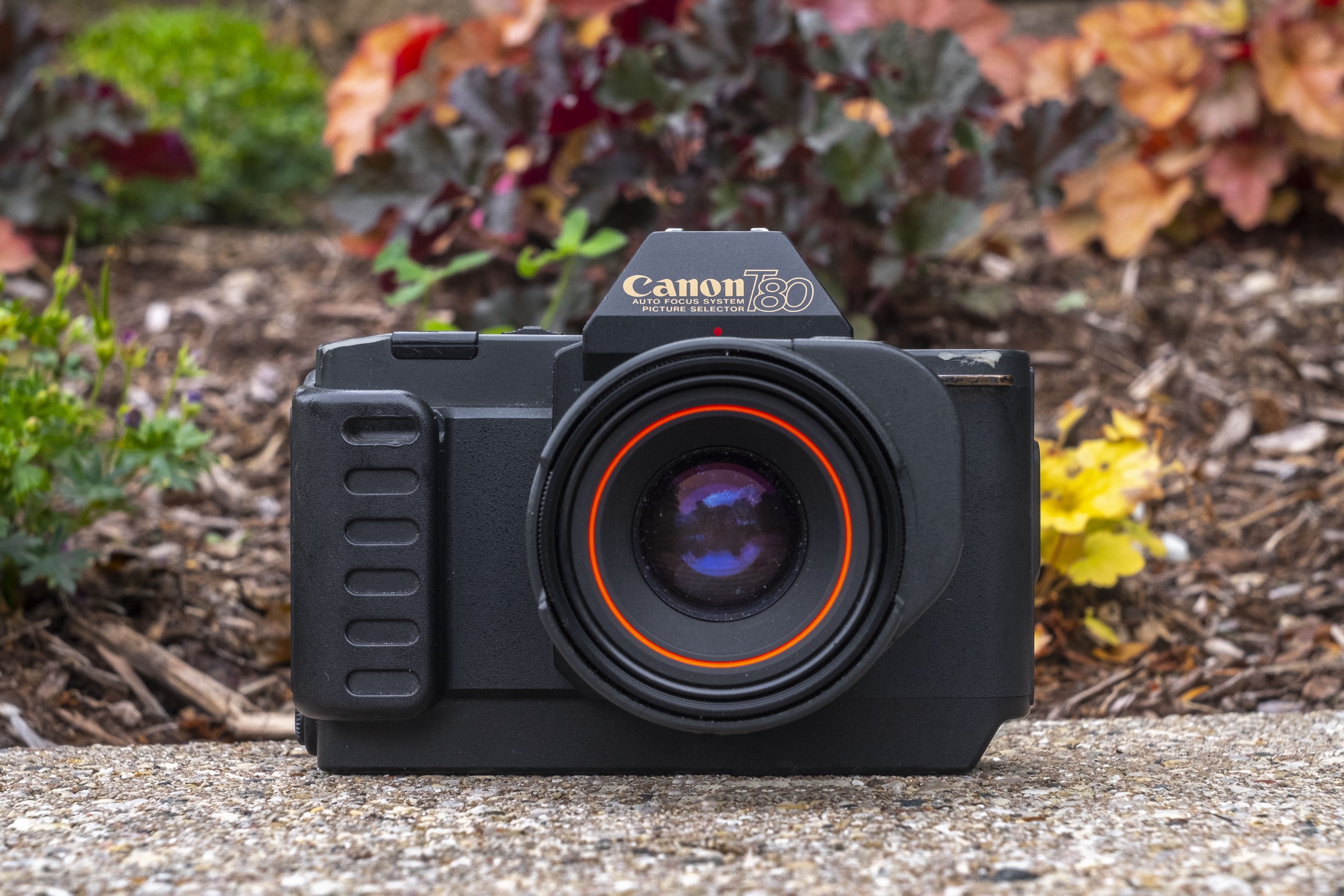

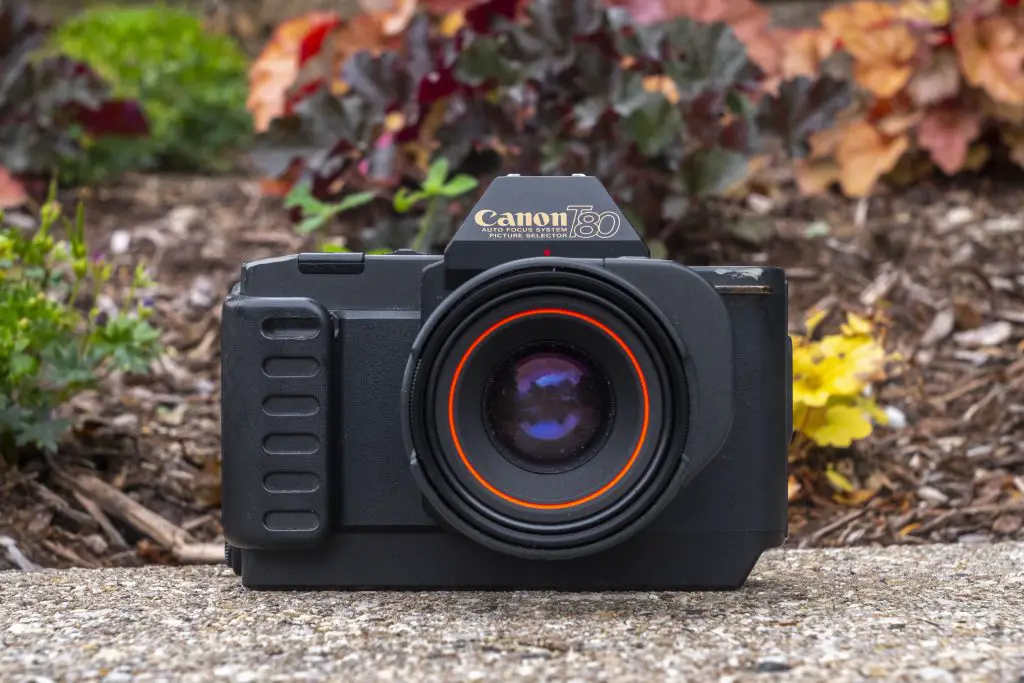
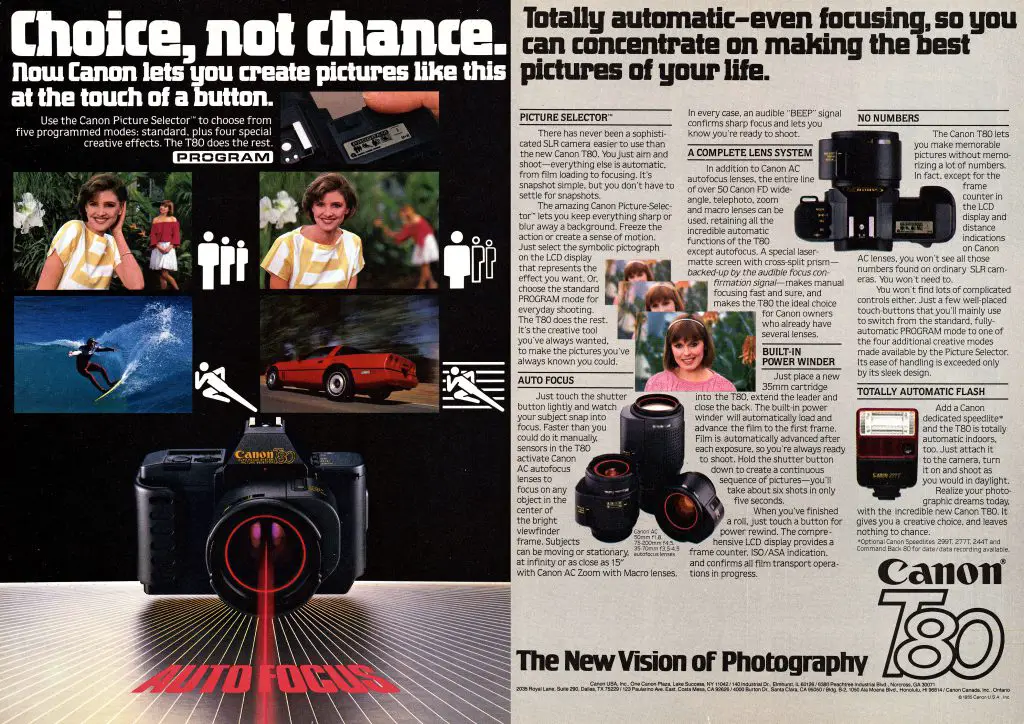
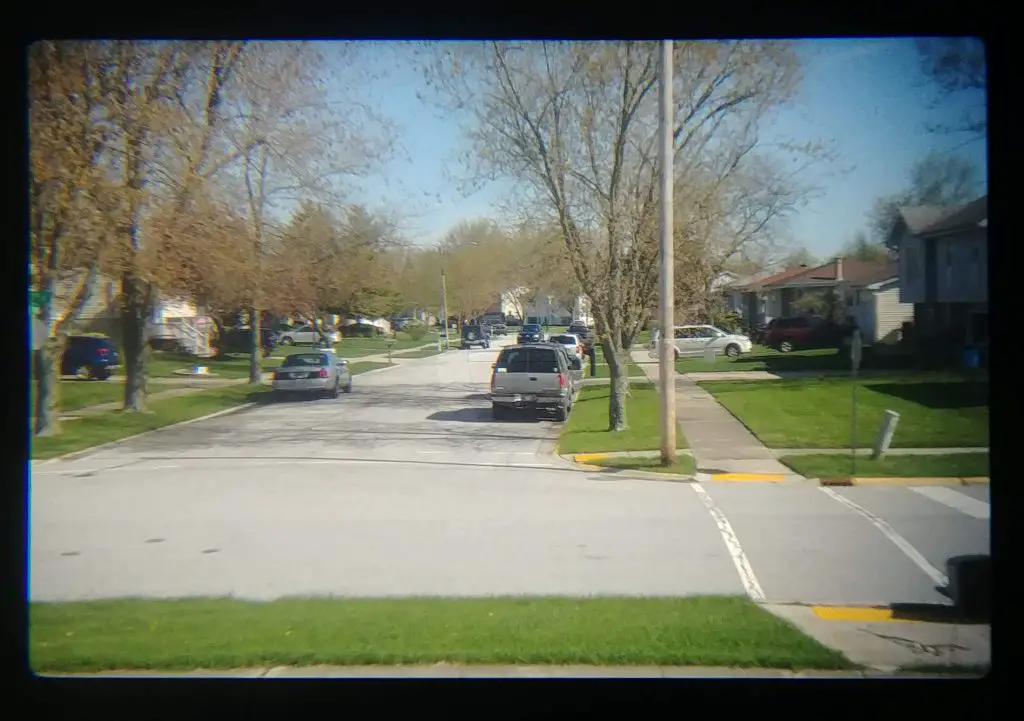
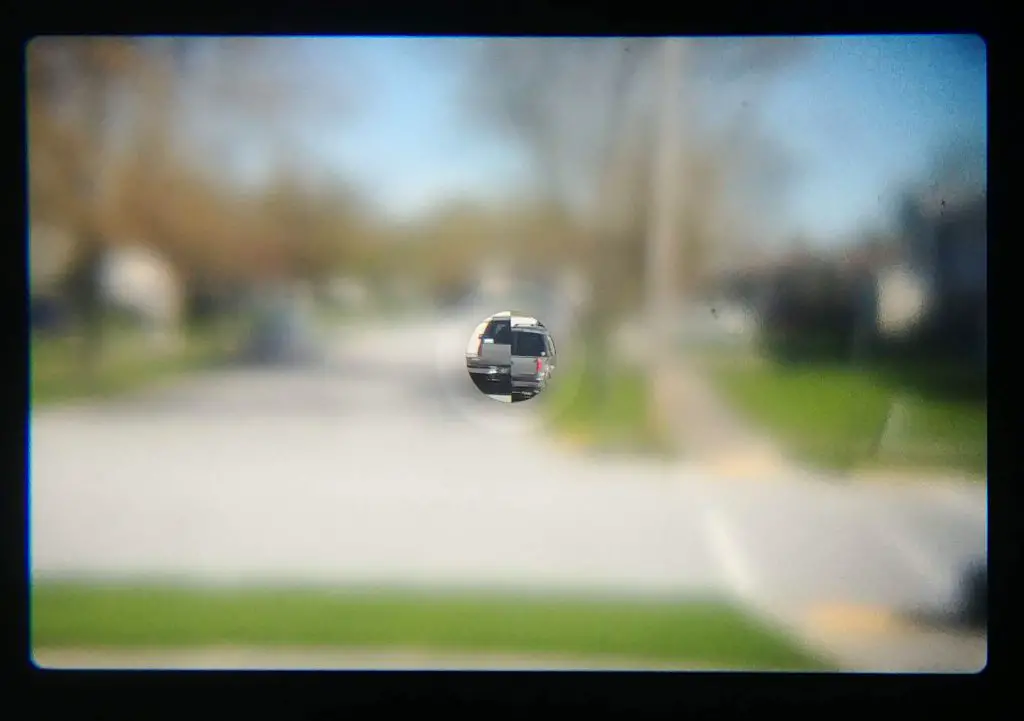


















Another super write-up! always thought these were pretty nifty at the time-even liked the styling. Didn’t own one then- I was a Nikon guy pretty much committed to various F’ models. I have the range now and they all function pretty well-guess I am lucky with the T90
Thank you Mike — another great “magazine-worthy” review! Now I have to put one of these on my “Wanted” list! I have ended up with a batch of Maxxum 7000s and bag of compatible lenses, and I must admit that the AF is pretty good (albeit noisy and slow compared to my Panasonic mirrorless) — and they are fun to use. For me it is a nifty “bridge” between my (way too many) more vintage film cameras and my mirrorless camera. So now I’ll see if I can affordably add a working T80 to my collection! As always — have fun and stay safe!!!
Always happy to help spend other people’s money! Although the T80 isn’t super common, usually when I see them come up for sale, the prices are very reasonable though, so I don’t expect you should have too much difficulty finding an affordable example.
My first experience with an autofocus SLR was the Maxxum 5000 that I borrowed from a friend in 1989. It was a fun camera to use and I got lots of good photos with it. I’ll say one thing. The T80 is noisier than the 1st gen Maxxums. But it is capable of some excellent images as well. I think you’ll appreciate it once you get used to he quirks with its AF.
I bought a used T80 about 16 months ago. I wanted a fully automatic SLR to carry with me when I went walking on my lunch hour yet did not want to carry my EOS gear with me. I also was curious to see if it really was such a horrible camera as others have made it out to be. Upon receiving the camera and putting my first roll through it, I was pleasantly surprised as well as impressed. Yes, that autofocus system was quite slow. It had troubles finding focus where my EOS 620 had no issues. But for what I use it for, landscapes and architecture, it’s quick enough. Most of my focusing takes place at 20ft and beyond so the lens doesn’t have far to move. When focus is achieved, it’s very accurate.
Also, the exposure system is very good and accurate. I’ve had very high quality images from the various exposure modes. Many times due to the distance of the subject matter, standard program works perfectly. But when I experiment with the various other scene modes, I get great results.
All in all, the T80 works great for my intended purposes for quick grab shots when I don’t want to take a lot of time nor don’t have a lot of time to grab my photos. Most of my photos are taken with my FTb or my two EOS bodies as I’ll often shoot in manual mode. But again, when I want simplicity, the T80 gets the nod.
The T80 really is a good camera undeserving of it’s less than stellar reputation.
Donald, I absolutely agree that the T80 is definitely not deserving of it’s often terrible reputation. As you noted, for general photography, it works great, and that double split image focusing aide in the ground glass is truly special!
Mike, if there was one minor nitpick I had, it was with the filter threads. It uses 52mm filters but I have 55 as my smallest size. Trying to use a 52-55 step up ring will not work because the front element retracts inside the front shroud. When that happens, the filter adapter will obstruct the front element and it will not allow one to focus beyond 5ft or so. I solved the problem temporarily by getting optical grade polycabonate filters just to have as the price was right. But eventually I’ll be getting a couple B+W filters for black and white photography.
I was also lucky enough to get a 299T flash with my body which included the 35-70. I have the 50 and the 75-200 lenses too. It is my opinion that the focusing slowness was due in part to the size of the focus motors on each lens and all that inertia of the mechanisms to overcome. Had the engineers been able to put EOS-sized focus motors in each lens, the speed would be vastly improved
I shot a roll of Ilford PanF in Pittsburgh’s Oakland neighborhood for some architectural photos and it was just beautiful! Images were nice and crisp. I mean, they were comparable to if they were shot with my Minolta Autocord TLR!. So much for the focusing being of poor quality! And definitely nothing about the photos screamed “T80!” from looking at them.
I suspect that people feel that since the T80 got hammered in sales by the Minolta Maxxum, then the camera must have been bad…